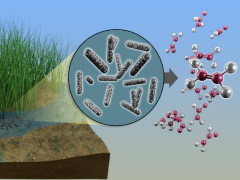Features
Sulfur scavengers emit ethylene
Date: 2020-08-28 13:07:15.0
Author: Jon Evans

The soil bacterium R. rubrum can produce
ethylene as by-product of scavening sulfur
from its waste products.
Image: Andy Sproles/ORNL, US Dept. of
Energy.
Ethylene (C2H4) is one of the cornerstones of the chemical industry, used in the manufacture of everything from major plastics such as polyethylene to adhesives and coolants. As such, it has the largest annual production of any organic compound, at around 150 million tonnes, all of which is derived from fossil fuels. But that could change, thanks to the discovery by a team of US researchers of a novel process by which certain anaerobic bacteria can produce ethylene from natural materials.
Various species of aerobic bacteria are known to be able to produce ethylene as a by-product of their metabolism. But the possibility of using them as the basis of a biotechnological process for producing ethylene at industrial scales has been hampered by the fact that ethylene and oxygen don't mix well.
"For about a decade, researchers have studied the biological production of ethylene through a different mechanism that occurs in oxygenated environments," said Justin North, a research scientist at Ohio State University. "There is a technical hurdle to scaling up that process as ethylene and oxygen mixed at industrial scales could be explosive." Hence the interest in finding anaerobic bacteria that can produce ethylene without the need for oxygen.
North and his team made their discovery while studying sulfur metabolism in the soil bacterium Rhodospirillum rubrum, which is a facultative anaerobe, able to conduct aerobic or anaerobic respiration depending on the conditions. Like nitrogen and phosphorus, sulfur is an essential nutrient for living organisms, required for producing the sulfur-containing amino acids methanethiol and cysteine. The researchers found that when growing anaerobically under sulfur-poor conditions, R. rubrum would start scavenging sulfur from its own waste products, especially a compound called (2-methylthio)ethanol, releasing ethylene in the process.
"We know these bacteria are producing hydrogen and consuming carbon dioxide," North said. "But, lo and behold, they were making copious amounts of ethylene gas. And we thought, well, that's weird."
To find out more about this process, North and his team used mass spectrometry to analyze the proteins produced by R. rubrum under both sulfur-poor conditions, when it produced ethylene, and sulfur-rich conditions, when it didn't. This revealed several proteins that increased in abundance by a factor of more than 20 under the sulfur-poor conditions.
These proteins were similar to some of the enzymes involved in the fixing of nitrogen, and North and his team were able to identify the genes that coded for them. When they deleted these genes, the resultant strains were no longer able to scavenge sulfur or produce ethylene.
As they report in a paper in Science, North and his team found that certain related species of bacteria, such as R. palustris and Blastochloris viridis, were also able to perform this sulfur-scavenging trick, whereas others, such as Rhodobacter capsulatus, weren't. But although this suggests the trait may be far from ubiquitous, it did prove to be quite versatile.
Waste products such as (2-methylthio)ethanol are types of volatile organic sulfur compounds (VOSCs), and North and his team decided to see what would happen if they exposed R. rubrum to other VOSCs. When they did this with dimethyl sulfide (DMS) and ethyl methyl sulfide (EMS), they found that R. rubrum could scavenge sulfur from both of them, but rather than producing ethylene, it resulted in the production of ethane with EMS and methane with DMS. And this methane was produced via a completely different metabolic process to that used by known methane-producing microbes.
Thus, North and his team have managed to stumble on a novel biological process for producing three important and widely used industrial chemicals. "We may have cracked a major technological barrier to producing a large amount of ethylene gas that could replace fossil fuel sources in making plastics," he said. "There's still a lot of work to do to develop these strains of bacteria to produce industrially significant quantities of ethylene gas. But this opens the door."
The views represented here are solely those of the author and do not necessarily represent those of John Wiley and Sons, Ltd. or of the SCI.
Displaying 2 keywords used to tag this article:
- Jules Audemars-Australia Best Quali
- DG6582 Mens Moncler Down Jackets Gr
